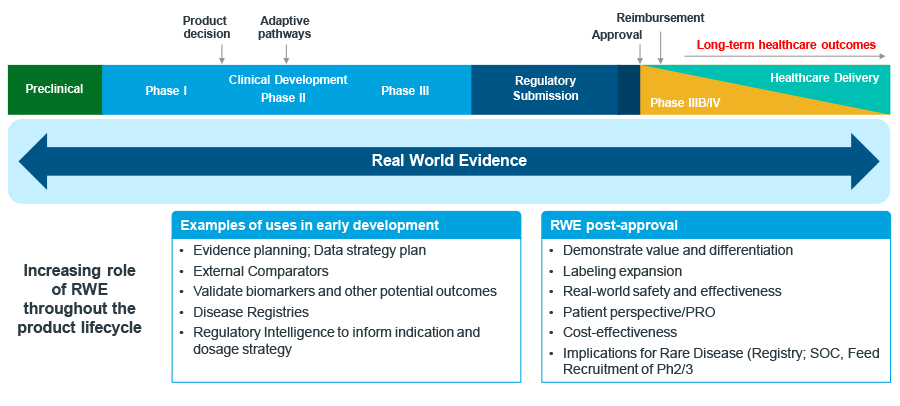















- Locations
- United States
- US Blogs
- FDA Guidance Documents
When considering the development lifecycle of any medical product, historically, it was commonly thought that real world data (RWD) and real world evidence (RWE) would have played a greater role from the approval phase forward.
However, what is evident today is that RWD and RWE can be leveraged throughout the product development lifecycle—even early stages, including:
- Evidence planning
- Data strategy planning
- Developing external comparators
- Validating biomarkers
- Using disease registry data to influence early development
- Early product planning
The evolving evidentiary landscape

RWD are data relating to patient health status or the delivery of healthcare that can be collected from a variety of sources. This can include (but is not limited to):
- Health insurance and claims data
- Mortality data
- Social media data
- Electronic medical records (EMR)
- Clinical outcome assessments
- Patient reported outcomes
- Wearables
- Patient registries
Uses and benefits of real world insights
These sources of RWD can then be utilized to influence RWE, which is clinical evidence about the usage—as well as potential risks and benefits—of a medical product that’s derived from the analysis of these RWD.
With these definitions in mind, let’s also consider the notion that RWE can inform strategy using RWD to
- understand unmet medical needs in many patient subgroups.
- inform strategic decision making to maximize the value of your assets.
- enhance clinical development, thereby accelerating and optimizing clinical trials in terms of feasibility, improving study designs, faster recruitment rates, or establishing clinical trial endpoints.
Additionally, RWE in health technology assessment (HTA) submissions can accelerate and improve access to the product, improve pricing, or even allow for premium pricing with market access.
More importantly, in terms of optimizing care pathways, RWE can be used to streamline patient journeys and support precision diagnoses, ultimately improving patient outcomes and faster accelerating product uptake.
When it comes to evidence, traditional randomized control trials (RCT) are still considered to be the gold standard for drug evidence, approval, and development. However, RCTs can be time and resource intensive – and are not broadly representative of patients seen in actual clinical care. That said, RCTs continue to be an integral source of data, particularly when bolstered by the impact of RWD. This is because RWD and RWE are based on patients seen in actual clinical care where a much more heterogeneous population is observed. This combination of RCTs, RWD, and RWE allows for significantly more informed and practical decision making.
Section 505F and the 21st Century Cures Act
So, where does section 505F of the Food, Drug, and Cosmetic Act figure into all of this?
The 21st Century Cures Act was passed with the intention to broaden and accelerate the drug development lifecycle; adding section 505F to the Food, Drug, and Cosmetic Act ultimately set the stage for the FDA to implement an RWD Framework. Under the RWE Framework, the FDA issued a series of guidance documents to meet the requirements of the Cures Act, which detail the agency’s current thinking on this topic.
One of the most recent guidance documents, issued in November 2021, focused on assessing registries to support regulatory decisions. This guidance contains information on three key concepts that should be considered when assessing registries for regulatory decision making:
- Relevance
- Reliability
- Data elements
At its core, the guidance asks: What is the research question and does the available registry data adequately address that question?
The guidance advocates for an established governance process for registry operations, not only to verify data accuracy and completeness, but to verify providence and traceability, for example, by incorporating:
- Data dictionaries
- Validated queries and edit checks
- Defined processes for collection, curation, management, and storage
- Processes for end-user access and interaction
- Terms and conditions for registry use
- Audit trails
Additional FDA guidance regarding the use of RWD/RWE to support regulatory decision making for drugs and biologics indicates that agreements should be in place to permit FDA inspection of data derived from third parties, and advocates for transparency by posting protocols and any other results to clinicaltrial.gov and/or ENCePP. The crux of this guidance is to maintain the reliability of RWD and data integrity from the point of origin through curation, transformation, and reporting of results.
Support resources
Fortunately, there is an impressive array of real-world resources to support regulatory decision making.
Several publications exist—some written by IQVIA staff— that describe how to operationalize registries and advance the framework for RWE regulatory use in the medical product space. In fact, several of these IQVIA publications have been cross-referenced within the FDA guidance documents.
Part of IQVIA’s mission is to advocate jointly for policies that encourage the use of RWD and RWE for regulatory decisions regarding medical products. We envision a future where RWD generated in everyday clinical practice can be utilized to support that decision making.
Interpreting FDA guidance documents and developing an approach on how to successfully operationalize FDA requirements is one of the core functions at IQVIA from a regulatory science and strategy perspective. We work both internally and with our partners at the RWE Alliance to dissect the FDA guidance documents and provide logical, fit-for purpose solutions that meet or exceed regulatory expectation.
Additional solutions include (but are not limited to):
- Optimizing regulatory outcomes and mitigating risk with holistic and tailored approaches to increasing agility through early engagement
- Identifying relevant evidence and developing data strategies to maximize utility of evidence generation
- Advancing the use of innovations for regulated products looking at the validation of new data methods and tools
- Provide training with OMOP and CDM via conversion workshops and standard analytics training
Interested in learning more about how you can operationalize FDA guidance documents and how IQVIA can help? Click here to access our webinar on demand today.

The Evolution of RWD Curation and RWE Innovation
Recent FDA guidance documents on the use of RWD are shaping the future of evidence generation and regulatory science. View this on-demand webinar to discover how your organization can navigate data quality, curation, and management challenges for better research.
You may also be interested in
Related solutions
Our Real-World Evidence offerings turn diverse healthcare data into actionable insights, empowering confident decisions and better patient outcomes.




